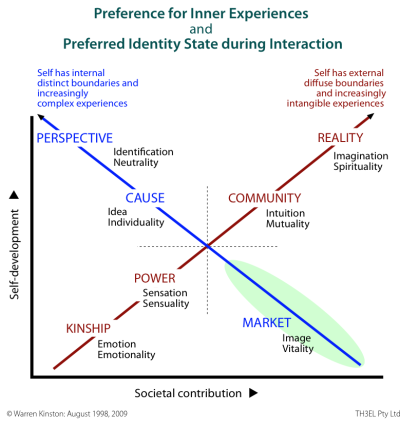Mental States 1: Inner Experiences
Self in Interaction
Our is what has feelings. During our interactions we automatically activate experiential flows: feelings, emotions, ideas, intuitions &c. Each of us must manage these dynamic mental states.
Each (= mentality) can be naturally associated with a particular type of feeling (= Level in the THEE ).
We all experience our self as having a boundary. What is «within the boundary» feels or is treated as if it were me. What is «without the boundary» feels or is treated as if it is not me. The two sets of differ sharply as to the nature of these boundaries.
Well-being Set
■ External diffuse self-boundaries
Moving up the diagonal, the prefer, support and foster increasingly intangible forms of experience.
- Kinship-centred individuals value emotions, and emotionality typifies their interactions. Manifestations include tearfulness, joyful expressions, tempers, outbursts and moods.

- Power-centred individuals value sensations, and sensuality is prominent in their make-up. Manifestations include extravagant tastes, love of luxury, unbridled sexuality and desire for constant stimulation.
- Community-centred individuals value intuition and use it to develop mutuality in their interactions. Manifestations include a search for self-awareness, attempts to empathize and understand others, expectations of reciprocity, acceptance of guilt, and inhibition of their own demands.
- Reality-centred individuals value imagination, and spirituality is intrinsic to their way of life. Manifestations include seeking the growth of consciousness, acceptance of the presence of mystery and cosmic forces, and taking a systemic and identity-based perspective on situations.
■ Internal distinct self-boundaries
Moving up the diagonal, the mentalities prefer, support and foster forms of experience.
- centred individuals value image because images are used to specify and communicate desired outcomes. include vitality, energetic work, enthusiasm, being fiercely competitive, a love of sports, and delight in displaying the trappings of success.
- centred individuals value ideas, essential to articulate and disseminate a discipline or dogma. These are held firmly rather than adopted by imitation, on instruction, or following fashion. include learning and arguing about: beliefs, commitments, ideals, inner convictions, plans and rules.
- centred individuals value identification because this is the form within which new ideas and value-sets are revealed. include socially identifying with an assigned or adopted role, and relating in terms of social role; identification with others leading to advocacy of peaceful coexistence; or identifying with all parties in a dispute, fostering impartial examination of evidence.
- Check commitment to action.
- Check social bonds.
Originally posted: July 2009